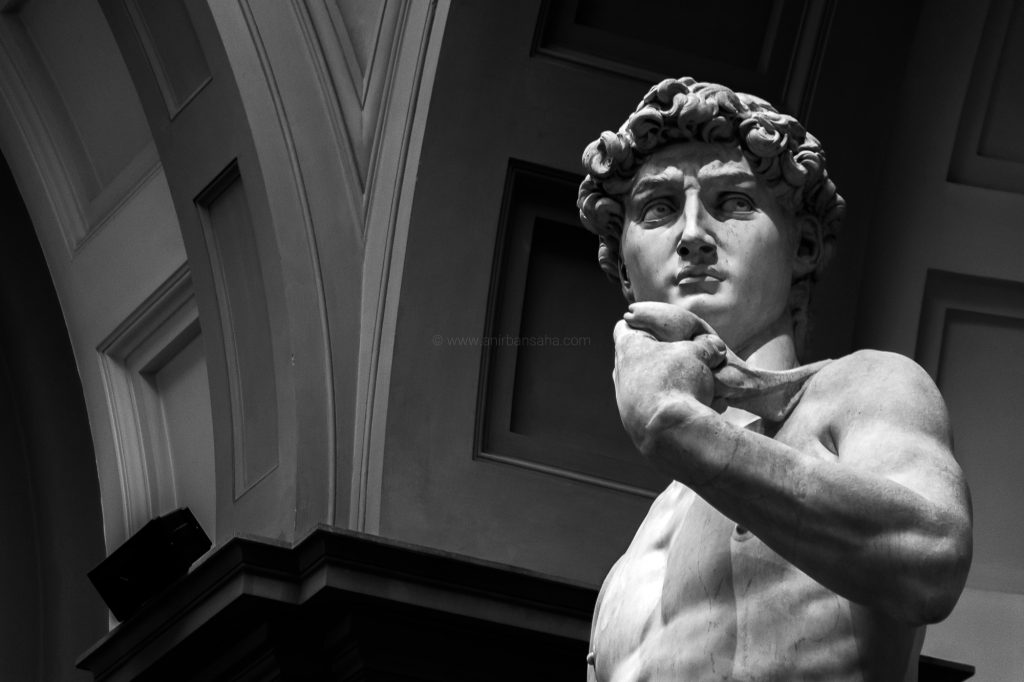David (Michelangelo): This statue has been talked, written, painted, photographed, discussed, debated for over 500 years. What more could I add to it? What I could do, for my readers is give a very brief introduction to each aspect of the statue. If that interests them, they could go and read further.
Renaissance and Italy:
Renaissance (meaning: rebirth) refers to the pre-modern era when Europe was getting back to its glory. There are various theories that suggest why Italy was the epicenter of the rediscovery; one being the fall of the Greeks to the Ottoman Turks (Muslim rulers) and the philosophers migrating to Italy. The second is the patronage of powerful families in different pockets in Italy that funded this explosion of art, sculpture, and philosophy. The explosion was fuelled by increased communication – the discovery of printed press in Germany.
Different prominent European names that we’ve known in our childhood like Leonardo Da Vinci, Michelangelo, Raphael or even William Shakespeare belongs to this era.
It started in Florence (Italy) and spread to different pockets in Italy – Venice, Rome, Milan and Bologna to name a few. It later spread to the rest of Europe. If you are in India reading this and you’ve studied the ICSE curriculum, you’ve probably read about this in your grade seven history books in overwhelming details. If you haven’t, please search about it if this interests you.
About Michelangelo:
A sculptor who carved David out of the rock and painter who painted the inside of the Sistine Chapel. If you love art of any form, the probability of you not having heard his name is almost zero.
If there is one person in the Renaissance period who drove me crazy during my school days, was this person. His work, of both Sistine Chapel and David, was the reason why I went to Italy. This is the link to his Wikipedia Page.
David and Goliath (Caravaggio)
About David in the Old Testament Bible:
David in the Old Testament Bible is the young warrior who defeated Goliath. “David versus Goliath” is now a proverb which means something small is fighting the big and is expected to win. “David” now is synonymous with “underdog”.
Goliath, the giant, asked the army of Israel to send the best of them so that combat between Goliath and the best could decide the fate of the war. But Saul, the ruler of Israelites was afraid. The young David, who brought food for his elder brothers, comes to know about this and accepts the challenge.
The ruler, Saul, agreed reluctantly and offered him the armor which David refused. David took the things he had, a sling and five pebbles from the brook.
The two faced each other. Goliath with his armor and a spear. David with a sling and five stones. After a slight verbal exchange in extreme Hollywood style, they start a fight. David swung a stone which hits Goliath in the center of his forehead; Goliath fell on his face on the ground. David swiftly slits his throat and cuts his head off.
Accademia Gallery in Florence, Italy.
About David, the statue:
David as represented by Michelangelo, is without Goliath; which traditionally has always been. Perhaps for the first time David was portrayed without a Goliath.
The moment represented in this statue is after he decided to fight the battle with Goliath and before he went ahead with it. “A moment between conscious choice and action”.
The weight of the body rests on the right leg while the left is loosened and forward. The body is comparatively relaxed and the torso slightly turning to the left, showing that the body is in motion. The eyes are determined. The right-hand holding stone, the veins visible, the muscles of the neck shows tension. The left hand holding the sling over the shoulder. The statue is nude for reasons not really known to me; the small genitals are in line with Michelangelo’s other works and with Renaissance conventions.
The figure has a slightly bigger head and the hand; it was supposed to be one of the statues on the roofline of the Florence Cathedral. But it wasn’t. Instead, it was placed at the Piazza Della Signoria. Today the statue of David is located in Accademia Gallery of Florence.
The statue of David is nearly 17 feet tall; that’s mammoth. It derives style from the Roman art and the face is inspired by Apollo – the Sun God. Over a period of time, it became a political symbol of resilience that represented Florence.
Did you know: Over 8 million tourist comes to see the statue of David every year on an average? But you don’t worry, I’ve photographed the statue from all possible angles and is presenting to you. If you like it, please share it with your friends.
[modula id=”11122″]- Test Post for Mobile Version Code Testing. - December 13, 2025
- Hoolock Gibbons in India: The Singing Apes Fighting for Survival. - June 10, 2025
- Finding Tagore in Germany & Czech Republic. - January 26, 2025
